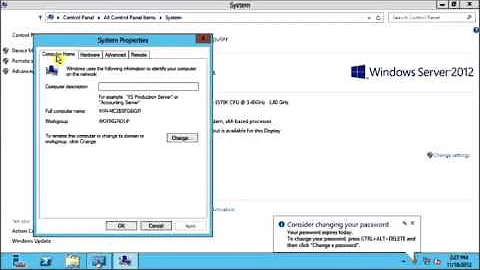How to change the computer name on a server configured by Puppet
Solution 1
EC2 will start with a unique name if the AMI that's starting it has been configured to set the Computer Name to the ip- in the EC2 Config Service.
See this: http://docs.aws.amazon.com/AWSEC2/latest/WindowsGuide/UsingConfig_WinAMI.html
Solution 2
For new relic, you just need to change your hostname as that is the identifier they use. Hostname changes do not require any restart, not at least for Linux. You can do following in puppet exec:
hostname `ifconfig eth0|grep "inet addr"| awk -F ":" '{print $2}'|awk '{print $1}'`
This will set your hostname as IP address and newrelic can use this as identifier. It would be easier for you too to diagnose issues as they will be shown against IP address of the machine.
Related videos on Youtube
Lloyd Christmas
Updated on September 18, 2022Comments
-
Lloyd Christmas over 1 year
I'm dealing with a very large list of large data frames (~2GB). To save space and reduce file size, I want to remove some elements of the list that are all
NA. As part of the operation I need togatherand then bind into a single data.frame.Here's an example:
library(tidyr) library(dplyr) a <- data.frame(x=rep(1,3), y1=1:3, y2=1:3) b <- data.frame(x=rep(2,3), y1=NA, y2=NA) c <- data.frame(x=rep(3,3), y1=1:3, y2=NA) l <- list(a,b,c) t <- lapply(l, function(x){ gather(x, key="type", value="value", -x) # %>% #remove list element here %>% #do other operations like mutate here }) %>% bind_rowsThe result of this includes some data.frames that are all
NAfor my values ofy.I would like to remove elements from the list completely. If remove all rows with
NAit still leaves me with an empty list element, which then crashes further calculations withmutateor other operations.I'm trying to take care of this operation with the first call to
lapplybecause I find that doing filtering after that requires a lot of memory (often crashing after maxing out the 16GB I have on this computer). In the title when I say "list" I'm referring to thisapplystatement.In this example the result should look like:
> t[-(7:12),] x type value 1 1 y1 1 2 1 y1 2 3 1 y1 3 4 1 y2 1 5 1 y2 2 6 1 y2 3 13 3 y1 1 14 3 y1 2 15 3 y1 3 16 3 y2 NA 17 3 y2 NA 18 3 y2 NA-
 SHYAMLAL over 11 yearsYeah, I thought about simply adding an exec for changing the machine name on the node when it's being configured by puppet, but unfortunately changing the machine name in windows requires a system reboot and I'm trying to prevent rebooting my systems just to install new relic.
SHYAMLAL over 11 yearsYeah, I thought about simply adding an exec for changing the machine name on the node when it's being configured by puppet, but unfortunately changing the machine name in windows requires a system reboot and I'm trying to prevent rebooting my systems just to install new relic.
-
-
 SHYAMLAL over 11 yearsthanks for the answer, I guess I should update my question to specify that I am trying to do this both for Linux nodes and Windows Server 2008 R2 nodes.
SHYAMLAL over 11 yearsthanks for the answer, I guess I should update my question to specify that I am trying to do this both for Linux nodes and Windows Server 2008 R2 nodes. -
Lloyd Christmas almost 7 yearsI'm trying to avoid create separate variable, i.e. doing as much as I can with pipes. If I create separate variables I run out of memory. Can I bring the
subsetstatement inside thelapplystatement and use pipes? -
 Yannis Vassiliadis almost 7 years@LloydChristmas with the example you provided, you can! In general, I don't see why you wouldn't, given that the output from
Yannis Vassiliadis almost 7 years@LloydChristmas with the example you provided, you can! In general, I don't see why you wouldn't, given that the output fromsubsetis a list itself. -
Lloyd Christmas almost 7 yearsThanks. This does seem to work. Although it results in a nested
lapplystatement. I will test this on my larger dataset and see if it is computationally viable. Revised code:lapply(l, function(x){ gather(x, key="type", value="value", -x) %>% subset(unlist(lapply(l, function(x) !all(is.na(x[,-1])))))}) %>% bind_rows -
 Yannis Vassiliadis almost 7 yearsWith the revised code you provided at don't get the same results. I get the right results, if I first use
Yannis Vassiliadis almost 7 yearsWith the revised code you provided at don't get the same results. I get the right results, if I first usegatherto gettand then subset it. -
Lloyd Christmas almost 7 yearsYou're right. This greatly simplified code works well. If you update answer to reflect it I will accept.
lapply(l, function(x){ gather(x, key="type", value="value", -x) %>% subset(!sum(!is.na(value)) == 0) }) %>% bind_rows




